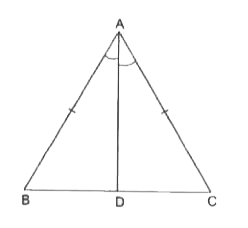If two isosceles triangles have a common base, prove that the line segment joining their vertices bisects the common base at right angles.
To prove that the line segment joining the vertices of two isosceles triangles with a common base bisects the base at right angles, we can follow these steps:
1. Identify the Triangles:
Let the two isosceles triangles be △ABD and △ACD with a common base BC. Here, AB=AC and BD=CD.
2. Label the Points:
Let A be the vertex of triangle ABD and D be the vertex of triangle ACD. The common base is BC.
3. Establish Congruence:
Since both triangles are isosceles, we have:
- AB=AC (sides of triangle ABD and ACD)
- BD=CD (sides of triangle ABD and ACD)
- AD=AD (common side)
4. Apply the SSS Congruence Criterion:
By the Side-Side-Side (SSS) congruence criterion, we can conclude:
△ABD≅△ACD
5. Corresponding Angles are Equal:
Since the triangles are congruent, the corresponding angles are equal:
∠BAD=∠CAD
6. Sum of Angles on a Straight Line:
The angles ∠BAD and ∠CAD are adjacent angles on a straight line BC. Therefore:
∠BAD+∠CAD=180∘
7. Finding Right Angles:
Since ∠BAD=∠CAD, we can denote each angle as x:
2x=180∘⟹x=90∘
Thus, ∠BAD=∠CAD=90∘.
8. Conclusion:
The line segment AD bisects the base BC at right angles, proving that AD is perpendicular to BC.
Let the two isosceles triangles be △ABD and △ACD with a common base BC. Here, AB=AC and BD=CD.
Let A be the vertex of triangle ABD and D be the vertex of triangle ACD. The common base is BC.
Since both triangles are isosceles, we have:
- AB=AC (sides of triangle ABD and ACD)
- BD=CD (sides of triangle ABD and ACD)
- AD=AD (common side)
By the Side-Side-Side (SSS) congruence criterion, we can conclude:
△ABD≅△ACD
Since the triangles are congruent, the corresponding angles are equal:
∠BAD=∠CAD
The angles ∠BAD and ∠CAD are adjacent angles on a straight line BC. Therefore:
∠BAD+∠CAD=180∘
Since ∠BAD=∠CAD, we can denote each angle as x:
2x=180∘⟹x=90∘
Thus, ∠BAD=∠CAD=90∘.
The line segment AD bisects the base BC at right angles, proving that AD is perpendicular to BC.
Topper's Solved these Questions
- CONGRUENCE OF TRIANGLES AND INEQUALITIES IN A TRIANGLEBook:RS AGGARWALChapter:CONGRUENCE OF TRIANGLES AND INEQUALITIES IN A TRIANGLEExercise:Exercise 9A
Explore 27 Videos
- CONGRUENCE OF TRIANGLES AND INEQUALITIES IN A TRIANGLEBook:RS AGGARWALChapter:CONGRUENCE OF TRIANGLES AND INEQUALITIES IN A TRIANGLEExercise:Exercise 9B
Explore 16 Videos
- CIRCLES Book:RS AGGARWALChapter:CIRCLES Exercise:MULTIPLE CHOICE QUESTION(MCQ)
Explore 37 Videos
- COORDINATE GEOMETRYBook:RS AGGARWALChapter:COORDINATE GEOMETRYExercise:Multiple Choice Questions (Mcq)
Explore 22 Videos
Similar Questions
If two isosceles triangles have a common base, prove that the line joining their vertices bisects them at right angles.
View SolutionWhich two triangles have ∠B as common?

View SolutionProve that the bisector of the vertical angle of an isosceles triangle bisects the base at right angles.

View SolutionAxis the line segment joining the centres of two bases is called the axis of the cylinder.
View SolutionShow that the bisector of vertical angle of an isosceles triangle bisects the base at right angles.
View SolutionThe equation of the line bisecting the line segment joining the points (a,b) and (a',b') at right angle, is
View SolutionIf in an isosceles triangle, each of the base angles is 40°, then the triangle is
View SolutionFind the equation of the plane which bisects the line segment joining the points A(2,3,4)andB(4,5,8) at right angles.
View SolutionThe altitude from the vertex bisect the base in an isosceles triangle
View SolutionA square is incribed in an isoceles right triangle, so that the square and the triangle have one angle common. Show that the vertex of the sqare opposite the vertex of the common angle bisects the hypotenuse.
View Solution